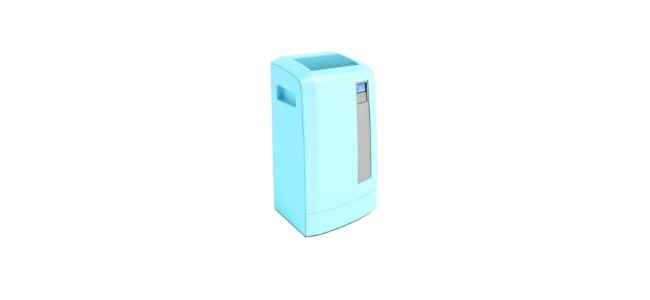
As you look at ways to cool your home, business, or warehouse, you are likely to encounter evaporative coolers. There’s an important question you have to ask: Do evaporative coolers increase humidity? Yes, they do. However, the amount of humidity produced is going to depend on a number of factors.
How Much Humidity is Produced?
There’s a difference between humidity and moisture. As such, you don’t want to confuse an evaporative cooler with a mist fan. The two are completely different – and produce very different environments.
Evaporative coolers require water, though it’s not a lot. There are some factors that will impact how much humidity is produced:
- Current temperature
- Current humidity level
- Strength of the fan
Often, you can expect to increase the humidity in the air by 10 to 20%. That may go up if the temperatures are low and it may go down if the humidity levels are already relatively high.
Now, there are ways to control the amount of humidity that is being produced from your evaporative cooler. Controls on the cooler will allow you to adjust the airflow. You can also make sure that the cooling medium isn’t soaked (it should be damp).
Additionally, if there is a particularly muggy day, you may want to pair your evaporative cooler with a dehumidifier. This way, you will be pulling the moisture out of the air at the same time that moist air is being produced. This is particularly important if you find that water molecules are actually landing within your space to create condensation.
There are plenty of ways to control the moisture in the air alongside the level of airflow. It all depends on the features of your evaporative cooler. If humidity levels are of particular importance to you, be sure you mention it as you begin looking at the various models on the market.
When Do Evaporative Coolers Stop Working Based on Humidity Levels?
It’s important to understand how evaporative coolers work. There’s an entire, physical process that happens. Dry air passes over a moist filter. The water helps to produce a cooler temperature and more humidity in the air as a result of evaporation.
If there’s already a significant amount of humidity in the air, the evaporative process doesn’t work as well. This means that when you reach a certain percentage of humidity, evaporative coolers won’t function as effectively.
Typically, if the air is at 40% humidity or higher, the evaporative cooler can’t create the evaporative process. This means that you won’t see the air getting cooled much, if at all.
If you live in an area where the humidity level is consistently above 40%, it would be better to look at a traditional HVAC system as opposed to an evaporative cooler. However, if you live in an area that is consistently hot and dry, with humidity levels at 25% or below, this can be one of the most cost-effective ways to cool the air.
The Benefits of Added Humidity
While some humidity, mixed with hot temperatures, can create a muggy environment, moisture in the air does have a lot of benefits. Particularly in dry areas like Nevada, New Mexico, and Texas, there isn’t enough moisture found in the air naturally. It leads many people to buy humidifiers so that they can produce more humidity.
With an evaporative cooler, you get the ability to cool the air and produce moisture, which means that there’s no need for the secondary investment of a humidifier.
Many doctors claim that the ideal level of humidity for health and comfort is between 30 and 50%. The reasons for this are numerous:
Allergies. Your allergies will be able to be managed more effectively with a higher humidity rate. One of the reasons for this is because the water molecules in the air weigh down the pollen and other allergens. They’re not roaming free in the air as much, so you’re not breathing them in as frequently.
Sinuses. If you’re susceptible to bloody noses when the air is dry, the higher humidity can actually help to keep everything moisturized. You’ll breathe in clean, moist air so that your sinuses can work more efficiently.
Skin. Your skin can dry out when there is little to no humidity in the air. It can lead to itchy, scratchy skin. With a higher humidity level, your skin stays moisturized so that you don’t have to worry about your skin shedding, cracking, or feeling itchy.
There are a few other benefits of humid air that has nothing to do with your health:
- Furniture can last longer because it’s not experiencing the cracking and warping of dry air.
- Wooden floors stay in better shape because they’re not drying out.
In the end, you have to maintain the perfect balance of humidity. You want some humidity in the air without being so humid that it feels as though water is just lingering in the air. A hygrometer can even be installed in your home or business so that you can learn of the humidity level and manage it more effectively.
How to Choose the Right Evaporative Cooler
With so many different types of evaporative coolers, you want to work with a reputable dealer who can help you choose the one that will offer the most efficiency for your space. Whether you need a residential, commercial, or industrial unit, you need to consider how much humidity is already present in the air. These types of coolers work best in hot, arid conditions.
You’ll want to get a unit that is sized properly for your space. Otherwise, you won’t get the cooling effects that you are after. Additionally, depending on where you’re using your cooler and what the temperature is outside, there are certain features that are more sought after. Some coolers can be used in the winter so that you can still enjoy the added humidity. Low-fan settings can still add moisture without cooling the air more.
With an evaporative cooler, it can be the answer you’ve been looking for if you want to achieve both cooler temperatures and a bit more humidity.











